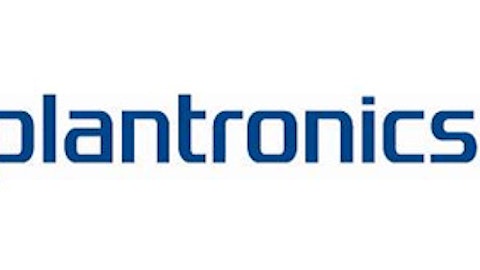Out of thousands of stocks that are currently traded on the market, it is difficult to identify those that will really generate strong returns. Hedge funds and institutional investors spend millions of dollars on analysts with MBAs and PhDs, who are industry experts and well connected to other industry and media insiders on top of that. Individual investors can piggyback the hedge funds employing these talents and can benefit from their vast resources and knowledge in that way. We analyze quarterly 13F filings of nearly 750 hedge funds and, by looking at the smart money sentiment that surrounds a stock, we can determine whether it has the potential to beat the market over the long-term. Therefore, let’s take a closer look at what smart money thinks about Plantronics, Inc. (NYSE:PLT).
Plantronics, Inc. (NYSE:PLT) was in 16 hedge funds’ portfolios at the end of December. PLT has seen a decrease in enthusiasm from smart money lately. There were 25 hedge funds in our database with PLT holdings at the end of the previous quarter. Our calculations also showed that PLT isn’t among the 30 most popular stocks among hedge funds.
So, why do we pay attention to hedge fund sentiment before making any investment decisions? Our research has shown that hedge funds’ small-cap stock picks managed to beat the market by double digits annually between 1999 and 2016, but the margin of outperformance has been declining in recent years. Nevertheless, we were still able to identify in advance a select group of hedge fund holdings that outperformed the market by 32 percentage points since May 2014 through March 12, 2019 (see the details here). We were also able to identify in advance a select group of hedge fund holdings that underperformed the market by 10 percentage points annually between 2006 and 2017. Interestingly the margin of underperformance of these stocks has been increasing in recent years. Investors who are long the market and short these stocks would have returned more than 27% annually between 2015 and 2017. We have been tracking and sharing the list of these stocks since February 2017 in our quarterly newsletter. Even if you aren’t comfortable with shorting stocks, you should at least avoid initiating long positions in our short portfolio.

Let’s take a glance at the fresh hedge fund action regarding Plantronics, Inc. (NYSE:PLT).
How are hedge funds trading Plantronics, Inc. (NYSE:PLT)?
At the end of the fourth quarter, a total of 16 of the hedge funds tracked by Insider Monkey were bullish on this stock, a change of -36% from one quarter earlier. On the other hand, there were a total of 17 hedge funds with a bullish position in PLT a year ago. With hedgies’ sentiment swirling, there exists an “upper tier” of notable hedge fund managers who were increasing their holdings substantially (or already accumulated large positions).

According to Insider Monkey’s hedge fund database, Renaissance Technologies, managed by Jim Simons, holds the largest position in Plantronics, Inc. (NYSE:PLT). Renaissance Technologies has a $45.3 million position in the stock, comprising less than 0.1%% of its 13F portfolio. Coming in second is Millennium Management, managed by Israel Englander, which holds a $9.3 million position; less than 0.1%% of its 13F portfolio is allocated to the company. Other professional money managers that hold long positions consist of Ken Griffin’s Citadel Investment Group, D. E. Shaw’s D E Shaw and David Costen Haley’s HBK Investments.
Since Plantronics, Inc. (NYSE:PLT) has experienced bearish sentiment from the entirety of the hedge funds we track, it’s easy to see that there were a few fund managers who sold off their full holdings by the end of the third quarter. Intriguingly, Noam Gottesman’s GLG Partners cut the biggest investment of all the hedgies watched by Insider Monkey, worth close to $21.6 million in stock, and Joel Greenblatt’s Gotham Asset Management was right behind this move, as the fund sold off about $3.8 million worth. These transactions are interesting, as aggregate hedge fund interest was cut by 9 funds by the end of the third quarter.
Let’s now take a look at hedge fund activity in other stocks – not necessarily in the same industry as Plantronics, Inc. (NYSE:PLT) but similarly valued. These stocks are Autolus Therapeutics plc (NASDAQ:AUTL), Mallinckrodt plc (NYSE:MNK), Instructure, Inc. (NYSE:INST), and Aircastle Limited (NYSE:AYR). All of these stocks’ market caps are similar to PLT’s market cap.
| Ticker | No of HFs with positions | Total Value of HF Positions (x1000) | Change in HF Position |
|---|---|---|---|
| AUTL | 6 | 408867 | -5 |
| MNK | 22 | 223543 | 2 |
| INST | 22 | 324837 | 4 |
| AYR | 13 | 80135 | -2 |
| Average | 15.75 | 259346 | -0.25 |
View table here if you experience formatting issues.
As you can see these stocks had an average of 15.75 hedge funds with bullish positions and the average amount invested in these stocks was $259 million. That figure was $72 million in PLT’s case. Mallinckrodt plc (NYSE:MNK) is the most popular stock in this table. On the other hand Autolus Therapeutics plc (NASDAQ:AUTL) is the least popular one with only 6 bullish hedge fund positions. Plantronics, Inc. (NYSE:PLT) is not the most popular stock in this group but hedge fund interest is still above average. Our calculations showed that top 15 most popular stocks) among hedge funds returned 24.2% through April 22nd and outperformed the S&P 500 ETF (SPY) by more than 7 percentage points. Hedge funds were also right about betting on PLT as the stock returned 60.2% and outperformed the market by an even larger margin. Hedge funds were rewarded for their relative bullishness.
Disclosure: None. This article was originally published at Insider Monkey.




